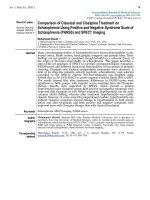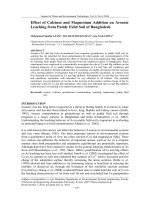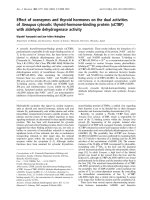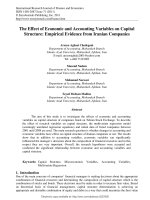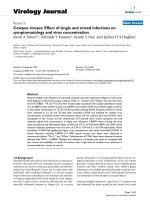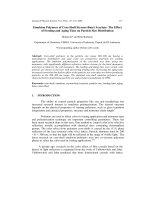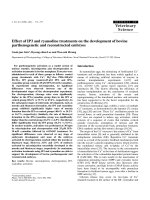Effect of soaking and gaseous treatment on GABA content ingerminatedbrownrice
Bạn đang xem bản rút gọn của tài liệu. Xem và tải ngay bản đầy đủ của tài liệu tại đây (266.44 KB, 5 trang )
Effect of soaking and gaseous treatment on GABA content
in germinated brown rice
Noriko Komatsuzaki
a,b,c,
*
, Kikuichi Tsukahara
b
, Hidechika Toyoshima
c
,
Tadanao Suzuki
c
, Naoto Shimizu
a
, Toshinori Kimura
a
a
Graduate School, University of Tsukuba, 1-1-1 Tennoudai, Tsukuba, Ibaraki 305-8572, Japan
b
Domer, Inc., 3-3-19 Tokiwagi, Ueda, Nagano 386-0027, Japan
c
National Food Research Institute, 2-1-2 Kannondai, Tsukuba, Ibaraki 305-8642, Japan
Received 22 April 2005; accepted 28 October 2005
Available online 20 December 2005
Abstract
To establish a new method of processing germinated brown rice (GBR), we processed grain of cultivars with a large germ by soaking
and gaseous treatment. After soaking for 3 h and gaseous treatment for 21 h at 35 °C, the content of c-aminobutyric acid (GABA) in
GBR (24.9 mg/100 g) was higher than that by the conventional soaking method (10.1 mg/100 g). Although the number of microorgan-
isms on the surface of the GBR increased during soaking, steaming for 20 min and ethanol treatment for 3 min completely sterilized the
GBR and did not reduce the amount of GABA.
Ó 2005 Elsevier Ltd. All rights reserved.
Keywords: GABA; Germination; Brown rice with a large germ; Gaseous treatment
1. Introduction
c-aminobutyric acid (GABA) is a free amino acid widely
distributed in nature, and is a neurotransmitter in the brain
and spinal cord of mammals (Manyam, Katz, Hare, Kan-
ifefski, & Tremblay, 1981). GABA is produced primarily
by the decarboxylation of
L-glutamic acid, catalyzed by
the enzyme, glutamate decarboxylase (GAD) [EC4.1.1.15]
(Mayer, Cherry, & Rhodes, 1990). GABA has several
physiological functions such as neurotransmission and
induction of hypotensive effects, diuretic effects, and tran-
quilizes effects (Jakobs, Jaeken, & Gibson, 1993; Okada
et al., 2000; Omori et al., 1987). Germinated brown rice
(GBR) extracts containing GABA inhibited cancer cell
proliferation (Oh & Oh, 2004).
Methods to increase GABA concentrations of food have
been studied up to today. For example, GABA is higher in
Gabaron tea, an anaerobically incubated tea (Sawai et al.,
1999; Tsushida & Murai, 1987), in bean sprouts (soybean,
black gram, green gram) treated with carbon dioxide
(Katagiri & Shimizu, 1989), and in brown rice processed
by high-pressure treatment (Kinefuchi, Sekiya, Yamazaki,
& Yamamoto, 1999a).
GBR is produced by soaking brown rice grains in water
to promote germination, and GABA accumulates during
this process. GBR contains vitamins, minerals, fiber, and
effective components such as phytic acid (Graf & Empson,
1987; Hunt, Johnson, & Juliano, 2002) and ferulic acid
(Tian, Nakamura, & Kayahara, 2004). Although normal
brown rice has high nutritional value, its popularity is
low because it cannot be cooked in a conventional rice coo-
ker. However, GBR is easily cooked and the texture is
softer than that of brown rice. Therefore, GBR could
become a popular healthy food. In this study, we examined
the accumulation of GABA in GBR and proposed a new
method of processing.
During the soaking of rice grains in water at 30–35 °C for
more than 20 h such as in the commercial parboiling of rice,
0260-8774/$ - see front matter Ó 2005 Elsevier Ltd. All rights reserved.
doi:10.1016/j.jfoodeng.2005.10.036
*
Corresponding author. Address: Graduate School, University of
Tsukuba, 1-1-1 Tennoudai, Tsukuba, Ibaraki 305-8572, Japan.
E-mail address: ffrc.go.jp (N. Komatsuzaki).
www.elsevier.com/locate/jfoodeng
Journal of Food Engineering 78 (2007) 556–560
microorganisms multiply greatly (Bandara, Vithanege, &
Bean, 1991). Methods of reducing microorganisms during
the production of GBR include high-pressure treatment of
rice (Kinefuchi, Sekiya, Yamazaki, & Yamamoto, 1999b),
ultraviolet irradiation (Suzuki & Maekawa, 1999), and dis-
infections by electrochemical treatment ( Feng et al., 2004).
There are still problems in the effectiveness on the process-
ing cost. Therefore, we investiga ted the effect of steaming
and ethanol treatment after soaking stage on the disinfec-
tions of GBR in order to solve those problems.
2. Materials and methods
2.1. Materials
We used five cultivars of Oryza sativa L. ssp. Japon-
ica:Haiminori and Oou 359, with a large germ, and Kos hi-
hikari, Yumetsukushi,andNipponbare, with a normal size
germ. All were harvested in 1999 or 2001. All samples were
stored in a refrigerator at 4 °C for 6 months.
2.2. Measurement of hydration characteristics of GBR
during soaking
We investigated the hydration characteristics of Haimi-
nori and Nipponbare brown rice. Grains were soaked in
water at 35 °C. Samples were removed and weighed at
specified times during soaking: 0.5, 1, 2, 3, 5, 10, 14, 18,
22, and 24 h. After soaking, the rice was dried at 135 °C
for 3 h. The moisture content of each lot was calculated.
2.3. Preparation of GBR by soaking and gaseous treatment
(GBR–SGT)
Washed grains (100 g) of all five cultivars were soaked in
water at 35 °C for 24 h. After germination, the wat er was
drained off and grains were washed again. These grains
were used as the control. Soaking and gaseous treatment
(SGT) was carried out as shown in Fig. 1. Lots of washed
rice grains (100 g) were soaked in water at 35 °C for 0.5, 1,
2, 3, 4, or 5 h, and then separately packed in six plastic
boxes (12 cm · 8cm· 3 cm high) with a lid. These boxes
were put in an incubator at 35 °C for 23.5, 23, 22, 21, 20,
and 19 h, respectively. These grains were then taken out,
frozen at À20 °C, and lyophilized. The lyophilized grains
were pulverized to rice flour in a mill. The rice flour was
used for amino acid analysis.
2.4. Analysis of free amino acids in brown rice and GBR
Brown rice powder and GBR powder (2.5 g) were placed
in a screw test tube containing 25 ml of 70% (v/v) ethanol
solution. The mixture was vigorously mixed for 1 min at
room temperature and then centrifuged at 8000g at 4 °C
for 5 min. The supernatant was filtered (No. 2, filter paper,
Whatman, Kent, England) and collected in a flask. The
same volume of 70% ethanol solution was added to the
precipitates as described above, and the extraction was
repeated. The collected supernatant (50 ml) was dried with
an evaporator (EYELA, Tokyo, Japan) at 40 °C. The res-
idue was dissolved in 5 ml of lithium citrate elution buffer
(pH 2.2) containing 1.5 g tri-lithium citrate, 19.8 g citric
acid, 12.0 g LiCl and 20.0 g 2,2-thiodi ethanol (per) and
then filtered through a 0.45 lm Millipore filter. Portions
(20 ll) of the samples were injected into an amino acid ana-
lyzer (LC-11 A, Yanako, Kyoto, Japan) to measure the
amino acid contents.
2.5. Treatment of GBR by steaming and ethanol
Washed rice grains (Nipponbare, 100 g) were soaked in
water at 35 °C for 24 h. After germination, the water was
drained off and the rice grains were washed again. The
GBR was put in wire netting (15 cm diameter, 8 cm high),
steamed for 10, 20, or 30 min in a steamer (Watanabe Co.,
Japan), and then soaked in 100 ml of 70% (v/v) ethanol
solution for 3 min. The grains were frozen at À20 °Cand
prepared for amino acid analysis as above.
2.6. Microbiological methods
Steamed and ethanol-treated GBR (10 g) was put in a
flask containing 100 ml of 0.85% sodium chloride solution.
Total aerobic plate counts were determined on plate count
agar (Nissui Pharmaceutical Co., Ltd., Japan) incubated
for 48 h at 37 °C.
Washing
Drain Washing
Packaging
Gaseous treatment for germination (for 23.5,
23, 22, 21, 20, 19 h)
Freezing for analysis
Washing
Incubator (35 ˚C)
Soaking (at 35
º
C for 0.5, 1, 2, 3, 4, 5 h)
No exchange air
Fig. 1. Production of germinated brown rice (GBR) by soaking and
gaseous treatment (SGT).
N. Komatsuzaki et al. / Journal of Food Engineering 78 (2007) 556–560 557
3. Results and discussions
3.1. Hydration characteristics of brown rice with large germ
during soaking
As Fig. 2 indicates, the moisture content of Nipponbare
reached 35–36% after 24 h. In contrast, that of Haiminori
was greater than 35% after 2 h, and reached 43.6% after
24 h. The GBR products contained normal 30–35% mois -
ture. In raw wild rice, high moisture levels (35–50%) pro-
moted mold and bacterial growth (Lindenfelser, Ciegler,
& Hesseltine, 1978). The moisture content of Haiminori
GBR should be kept under 35%, similar to that of normal
brown rice.
3.2. Accumulation of free amino acids in GBR–SGT
Fig. 3 shows GABA contents in Haiminori GBR treated
by SGT. The highest GABA content (25.5 mg/100 g)
occurred with soaking for 3 h and gaseous treatment for
21 h. The moisture content of this GBR was 36.9%
(Fig. 2). Thus, 3 h was the optimal soaking time.
Table 1 shows the amino acid contents in Haiminori
brown rice (control), GBR (soaked at 35 °C for 24 h),
and GBR–SGT (21 h gas at 35 °C). In GBR, contents of
aspartic acid, serine, asparagine, and glutamic acid were
decreased, and others were increased. Amino acids stored
in brown rice as storage protein are decomposed by
water absorption, changed into transportable amide, and
supplied to the growing parts of the rice seedling (Lea,
Robinson, & Stewart, 1990). Therefore, on water absorp-
tion, glutamate decarboxylase (GAD) is activated, and glu-
tamic acid is converted to GABA.
In GBR–SGT, glutamine and glutamic acid were
increased, although GABA was also increased. This result
might indicate that the glutamic acid was synthesized by
the glutamate synthase (GOGAT) glutamine synthetase
(GS) cycle. The GS/GOGAT cycle plays an important
role in anaerobic accumulation of GABA and alanine
(Aurisano, Bertani, & Reggian i, 1995; Reggina, Nebuloni,
& Brambilla, 2000). Moreover, GABA increases rapidl y in
plant tissues in response to various forms of stress such as
hypoxia (Roberts, Callis, Wemmer, Walbot, & Jardetzky,
1984), cold shock, and darkness (Servaites, Schrader, &
Jung, 1979). We think that the SGT condition became
hypoxic in this experiment.
The GABA contents in the five cultivars of brown rice
were a ll significantly higher in the SGT method than in
the soaking treatment (Fig. 4). Oou 359 and Haiminori,
both with a large germ, had a clearly higher GABA content
than normal brown rice.
3.3. Evaluation of steaming and ethanol treatment of GBR
To evaluate the effectiveness of disinfection by steaming
and ethanol, we measured the aerobic plate counts (APC)
of GBR. APC increased above 10
8
cfu g
À1
after soaking
0
10
20
30
40
50
0 5 10 15 20 25
Soakin
g
time (h)
Moisture content (%)
Nipponbare Haiminori
Fig. 2. Hydration characteristics of Nipponbare and Haiminori during
soaking at 35 °C.
0
5
10
15
20
25
30
Soaked
for 0.5 h
Soaked
for 1 h
Soaked
for 2h
Soaked
for 3 h
Soaked
for 4 h
Soaked
for 5 h
GABA (mg/100 g FW)
Fig. 3. GABA content in GBR (Haiminori) after different soaking times.
Table 1
Free amino acid contents (mg/100 g FW) in Haiminori raw brown rice
(control), germinated brown rice (GBR), and GBR treated by soaking and
gaseous treatment
Amino acid Control GBR GBR by SGT
Asp 6.6 ± 1.04 1.2 ± 0.22 1.8 ± 0.61
Thr 1.0 ± 0.48 3.1 ± 0.76 6.0 ± 1.16
Ser 3.5 ± 0.29 2.0 ± 0.75 2.7 ± 0.42
Asn 7.1 ± 1.69 3.7 ± 0.55 7.0 ± 0.78
Glu 12.4 ± 3.06 4.5 ± 0.41 13.4 ± 3.57
Pro 1.9 ± 1.66 5.1 ± 0.67 8.4 ± 1.26
Gly 1.5 ± 0.89 4.3 ± 0.82 8.7 ± 1.50
Ala 12.2 ± 4.48 13.0 ± 2.00 25.6 ± 9.29
Val 0.8 ± 0.33 4.5 ± 0.76 12.3 ± 1.00
Cys 1.4 ± 0.51 1.9 ± 1.41 2.9 ± 0.70
Met 0.4 ± 0.40 2.2 ± 0.52 3.3 ± 1.01
I-Leu 0.7 ± 0.15 3.7 ± 0.67 5.8 ± 0.70
Leu 0.9 ± 0.17 6.4 ± 0.97 12.3 ± 1.31
Tyr 1.4 ± 0.39 4.1 ± 0.37 7.0 ± 0.33
Phe 1.0 ± 0.59 3.8 ± 0.37 5.5 ± 0.99
GABA 7.3 ± 2.05 10.1 ± 1.36 24.9 ± 4.00
Lys 3.9 ± 1.45 4.4 ± 0.84 9.6 ± 2.55
His 1.0 ± 0.30 2.4 ± 0.79 4.3 ± 0.99
Arg 4.9 ± 1.14 9.0 ± 3.06 10.6 ± 6.48
Total 67.0 ± 12.38 93.0 ± 13.34 178.7 ± 32.78
Data expressed as mean ± SD of three independent experiments.
558 N. Komatsuzaki et al. / Journal of Food Engineering 78 (2007) 556–560
at 35 °C for 24 h (Table 2). After steaming for 20 and
30 min, APC decreased from 10
8
to 10
2
cfu g
À1
. But steam-
ing and ethanol treatment for 20 and 30 min produced
a zero APC. In general, Bacillus and molds such as
Aspergillus are widely distributed in stored grain (Tsuruta,
Ikekawa, & Saito, 1984). Although they die when treated at
over 80 °C for 10 min (Rijal & Fujioka, 2003), it is possible
that bacterial spores survive. High-pressure treatment
reduced the viable bacterial count in brown rice, but num-
ber of bacterial spores subsequently increased (Kinefuchi
et al., 1999a, 1999b).
Consequently, only the combination of steaming and
ethanol treatment is completely effective.
We measured the effect of steaming and ethanol treat-
ment on the GABA content of GBR. Table 2 shows that
the GABA content in GBR–SGT was 11.3 mg, and that
GABA content was not affected by steaming and ethanol
treatment. Watanabe, Maeda, Tsukahara, Kayahara, and
Morita (2004) reported that GABA in bread containing
brown rice and GBR was almost completely decomposed
during the baking process. They suggested that heating
decomposed the GABA; however, steaming at less than
100 °C had no effect in our experiment.
4. Conclusion
Soaking and gaseous treatment (SGT) of Haiminori
grains (with a large germ) gave the highest concentration
of GABA in GBR.
Microorganisms multiplied during soaking were elimi-
nated by our recommended method, steaming for 20 min
and ethanol treatment for 3 min, without reduction of
GABA content.
Acknowledgments
This study was supported by the project, Development
of Technology for Versatile Uses of Carbohydrates by
Applying Glyco-Engineering, the Ministry of Agriculture,
Forestry and Fisheries, Japan as a collaborative effort
among industry, government, and academia.
References
Aurisano, N., Bertani, A., & Reggiani, R. (1995). Anaerobic accumulation
of 4-aminobutyrate in rice seedlings: causes and significance. Phyto-
chemistry, 38(5), 1147–1150.
Bandara, J. M., Vithanege, A. K., & Bean, G. A. (1991). Effect of
parboiling and bran removal on aflatoxin levels in Sri Lankan rice.
Mycopathologia, 115(1), 31–35.
Feng, C., Suzuki, K., Zhao, S., Sugiura, N., Shimada, S., & Maekawa, T.
(2004). Water disinfection by electrochemical treatment. Bioresource
Technology, 94, 21–25.
Graf, E., & Empson, K. L. (1987). Phytic acid: a natural antioxidant. The
Journal of Biological Chemistry, 262(24), 11647–11650.
Hunt, J. R., Johnson, L. K., & Juliano, B. O. (2002). Bioavailability of
zinc from cooked philippine milled, undermilled, and brown rice, as
assessed in rats by using growth, bone zinc, and zinc-65 retention.
Journal of Agricultural and Food Chemistry, 50(18), 5229–5235.
Jakobs, C., Jaeken, J., & Gibson, K. M. (1993). Inherited disorders of
GABA metabolism. Journal of Inherited Metabolic Disease, 16(4),
704–715.
Katagiri, M., & Shimizu, S. (1989). c-amino butyric acid accumulation in
bean sprouts (soybean, black gram, green gram) treated with carbon
dioxide. Nippon Shokuhin Kagaku Kougaku Kaishi, 36(11), 916–919 [in
Japanese].
Kinefuchi, M., Sekiya, M., Yamazaki, A., & Yamamoto, K. (1999a).
Accumulation of GABA in brown rice by high pressure treatment.
Nippon Shokuhin Kagaku Kougaku Kaishi, 46(5), 323–328 [in
Japanese].
Kinefuchi, M., Sekiya, M., Yamazaki, A., & Yamamoto, K. (1999b).
Change in viable bacteria count in brown rice containing accumulated
GABA by high pressure treatment, and properties of processed brown
rice. Nippon Shokuhin Kagaku Kougaku Kaishi, 46, 329–333 [in
Japanese].
Lea, P. J., Robinson, S. A., & Stewart, G. R. (1990). In B. J. Miflin & P. J.
Lea (Eds.). The biochemistry of plants (Vol. 16, pp. 121–159). London:
Academic Press.
Lindenfelser, L. A., Ciegler, A., & Hesseltine, C. W. (1978). Wild rice
as fermentation substrate for mycotoxin production. Applied and
Environmental Microbiology, 35(1), 105–108.
Manyam, B. V., Katz, L., Hare, T. A., Kanifefski, K., & Tremblay, R. D.
(1981). Isoniazid-induced elevation of cerebrospinal fluid (CSF)
GABA levels and effects on chorea in Hunitington’s disease. Annals
of Neurology, 10, 35–37.
Mayer, R., Cherry, J., & Rhodes, D. (1990). Effects of heat shock on
amino acid metabolism of cowpea cells. Plant Physiology, 94, 796–
810.
Oh, C. H., & Oh, S. H. (2004). Effect of germinated brown rice extracts
with enhanced levels of GABA on cancer cell proliferation and
apoptosis. Journal of Medicinal Food, 7(1), 19–23.
Okada, T., Sugishita, T., Murakami, T., Murai, H., Saikusa, T., Horio, T.,
et al. (2000). Effect of the defatted rice germ enriched with GABA for
sleepless, depression, autonomic Disorder by oral administration.
0
5
10
15
20
25
30
Koshihikari
Nipponbare
Yumetsukushi
Oou 359
Haiminori
GABA (mg/100 g FW)
Brown rice Soaking SGT
Fig. 4. Comparison of GABA contents in GBR between soaking and
SGT methods.
Table 2
Effect of GBR by steaming and ethanol treatment on GABA content and
APC
Treatment GABA (mg/100 g FW) APC (cfu g
À1
)
Control (brown rice) 4.1 1.7 · 10
4
GBR (soaking for 24 h) 9.6 1.9 · 10
8
Steamed for 10 min 9.2 2.2 · 10
3
Steamed for 20 min 10.1 1.0 · 10
2
Steamed for 30 min 9.8 1.0 · 10
2
Steamed for 10 min + ethanol 9.2 3.0 · 10
2
Steamed for 20 min + ethanol 9.1 ND
Steamed for 30 min + ethanol 8.8 ND
N. Komatsuzaki et al. / Journal of Food Engineering 78 (2007) 556–560 559
Nippon Shokuhin Kagaku Kougaku Kaishi, 47(8), 596–603 [in
Japanese].
Omori, M., Yano, T., Okamoto, J., Tsushida, T., Murai, T., & Higuchi,
M. (1987). Effect of anaerobically treated tea (gabaron tea) on blood
pressure of spontaneously hypertensive rats. Nippon Nogeikagaku
Kaishi, 61(11), 1449–1451 [in Japanese].
Reggina, R., Nebuloni, M., & Brambilla, I. (2000). Anaerobic accumu-
lation of amino acids in rice roots: role of the glutamine synthetase/
glutamate synthase cycle. Amino Acids, 18, 207–217.
Rijal, G. K., & Fujioka, R. S. (2003). Use of reflectors to enhance the
synergistic effects of solar heating and solar wavelengths to disinfect
drinking water sources. Water Science and Technology, 48, 481–488.
Roberts, J. K. M., Callis, J., Wemmer, D., Walbot, V., & Jardetzky, O.
(1984). Mechanism of cytoplasmic pH regulation in hypoxic maize
root tips and its role in survival under hypoxia. Proceedings of the
National Academy of Sciences of the United States of America, 81,
3379–3383.
Sawai, Y., Konomi, K., Odaka, Y., Yoshitomi, H., Yamaguchi, Y.,
Miyama, D., et al. (1999). Repeating treatment of anaerobic and
aerobic incubation increases the amount of c-aminobutyric acid in tea
shoots. Nippon Shokuhin Kagaku Kogaku Kaishi, 46(7), 462–466 [in
Japanese].
Servaites, J. C., Schrader, L. E., & Jung, D. M. (1979). Energy-dependent
loading of amino acids and sucrose into the phloem of soybean. Plant
Physiology, 64, 546–550.
Suzuki, K., & Maekawa, T. (1999). Microorganisms control during
processing of germinated brown rice (Vol. 9). The Society of Agricul-
tural Structures, Japan (pp. 137–144).
Tian, S., Nakamura, K., & Kayahara, H. (2004). Analysis of phenolic
compounds in white rice, brown rice, and germinated brown rice.
Journal of Agricultural and Food Chemistry, 52(15), 4808–4813.
Tsuruta, O., Ikekawa, N., & Saito, M. (1984). Heat generation and carbon
dioxide production of brown rice accused by fungus infection (Vol.
44). Repot National Food Research Institute, Japan (pp. 15–19).
Tsushida, T., & Murai, T. (1987). Conversion of glutamic acid to c-
aminobutyric acid in tea leaves under anaerobic conditions. Agricul-
tural and Biological Chemistry, 51(11), 2865–2871.
Watanabe, M., Maeda, T., Tsukahara, K., Kayahara, H., & Morita, N.
(2004). Application of pregerminated brown rice for breadmaking.
Cereal Chemistry, 81(4), 450–455.
560 N. Komatsuzaki et al. / Journal of Food Engineering 78 (2007) 556–560
